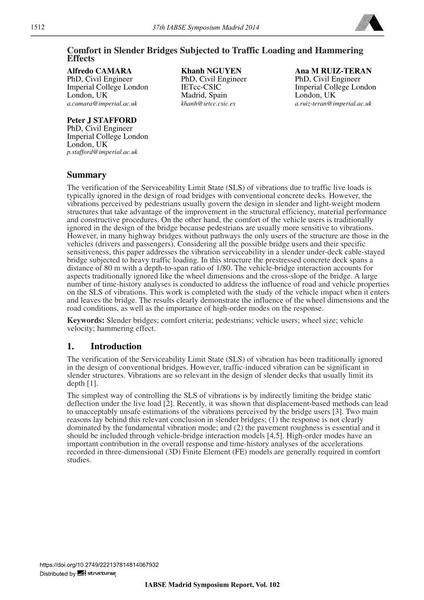Comfort in Slender Bridges Subjected to Traffic Loading and Hammering Effects

|
|
|||||||||||
Détails bibliographiques
| Auteur(s): |
Alfredo Camara
Khanh Nguyen Ana M. Ruiz-Teran Peter J. Stafford |
||||
|---|---|---|---|---|---|
| Médium: | papier de conférence | ||||
| Langue(s): | anglais | ||||
| Conférence: | IABSE Symposium: Engineering for Progress, Nature and People, Madrid, Spain, 3-5 September 2014 | ||||
| Publié dans: | IABSE Symposium Madrid 2014 | ||||
|
|||||
| Page(s): | 1512-1519 | ||||
| Nombre total de pages (du PDF): | 8 | ||||
| Année: | 2014 | ||||
| DOI: | 10.2749/222137814814067932 | ||||
| Abstrait: |
The verification of the Serviceability Limit State (SLS) of vibrations due to traffic live loads is typically ignored in the design of road bridges with conventional concrete decks. However, the vibrations perceived by pedestrians usually govern the design in slender and light-weight modern structures that take advantage of the improvement in the structural efficiency, material performance and constructive procedures. On the other hand, the comfort of the vehicle users is traditionally ignored in the design of the bridge because pedestrians are usually more sensitive to vibrations. However, in many highway bridges without pathways the only users of the structure are those in the vehicles (drivers and passengers). Considering all the possible bridge users and their specific sensitiveness, this paper addresses the vibration serviceability in a slender under-deck cable-stayed bridge subjected to heavy traffic loading. In this structure the prestressed concrete deck spans a distance of 80 m with a depth-to-span ratio of 1/80. The vehicle-bridge interaction accounts for aspects traditionally ignored like the wheel dimensions and the cross-slope of the bridge. A large number of time-history analyses is conducted to address the influence of road and vehicle properties on the SLS of vibrations. This work is completed with the study of the vehicle impact when it enters and leaves the bridge. The results clearly demonstrate the influence of the wheel dimensions and the road conditions, as well as the importance of high-order modes on the response. |
||||
